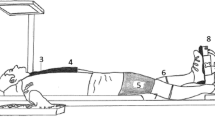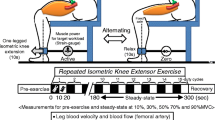Abstract
The splanchnic circulation can make a major contribution to blood flow changes. However, the role of the splanchnic circulation in the reflex adjustments to the blood pressure increase during isometric exercise is not well documented. The central command and the muscle chemoreflex are the two major mechanisms involved in the blood pressure response to isometric exercise. This study aimed to examine the behaviour of the superior mesenteric artery during isometric handgrip (IHG) at 30% maximal voluntary contraction (MVC). The pulsatility index (PI) of the blood velocity waveform of the superior mesenteric artery was taken as the study parameter. A total of ten healthy subjects [mean age, 21.1 (SEM 0.3) years] performed an IHG at 30% MVC for 90 s. At 5 s prior to the end of the exercise, muscle circulation was arrested for 90 s to study the effect of the muscle chemoreflex (post exercise arterial occlusion, PEAO). The IHG at 30% MVC caused a decrease in superior mesenteric artery PI, from 4.84 (SEM 1.57) at control level to 3.90 (SEM 1.07) (P = 0.015). The PI further decreased to 3.17 (SEM 0.70) (P = 0.01) during PEAO. Our results indicated that ergoreceptors may be involved in the superior mesenteric artery vasodilatation during isometric exercise.
Similar content being viewed by others
References
Alam M, Smith FH (1937) Observations in man upon a blood pressure raising reflex arising from the voluntary muscles. J Physiol (Lond) 89:372–383
Anderson EA, Wallin GI, Mark AL (1986) Dissociation of sympathetic nerve activity in arm and leg during mental stress. Hypertension 9 [Suppl 111]: III-114-III-119
Chaudhuri KR, Thomaides T, Hernandez P, Alam M, Mathias CJ (1991) Noninvasive quantification of superior mesenteric artery blood flow during sympathoneural activation in normal subjects. Clin Autonomic Research 1:37–42
Christensen JJ, Calbo H (1983) Sympathetic nervous activity during exercise. Annu Rev Physiol 45:139–145
Davies JA, Lee A, Spencer JA (1990) Variability of continous-wave Doppler flow velocity waveform indices from the umbilical artery. Obstet Gynecol 76:366–369
Downing GJ, Yarlagadda AP, Maulik D (1991) Comparison of the pulsatility index and input impedance parameters in a model of altered hemodynamics. J Ultrasound Med 10:317–321
Duprez DA, Essandoh LK, Vanhoutte PM, Shepherd JT (1989) Vascular responses in forearm and calf to contralateral static exercise. J Appl Physiol 66:669–674
Eklund B, Kaijser L, Knutsson E (1974) Blood flow in resting (contralateral) arm and leg during isometric contraction. J Physiol 240:111–124
Essandoh LK, Duprez DA, Shepherd JT (1987) Postural cardiovascular reflexes: comparison of responses of forearm and calf resistance vessels. J Appl Physiol 63:1801–1805
Gill RW (1985) Measurement of blood flow by ultrasound, accuracy and sources of error. Ultrasound Med Biol 11:625–641
Gosling RC, King DH (1974) Arterial assessment by Doppler-shift ultrasound. Proc R Soc Med 67:447–449
Hoskins PR, Loupas T, McDicken WN (1991) An investigation of simulated umbilical artery Doppler waveforms. I. The effect of these physical parameters on the maximum frequency envelope and on pulsatility index. Ultrasound Med Biol 17:7–21
Jäger K, Bollinger A, Balli C, Ammann R (1986) Measurement of mesenteric blood flow by duplex scanning. J Vasc Surg 3: 462–469
Kilbom A, Brundin T (1976) Circulatory effects of isometric muscle contractions, performed separately and in combination with dynamic exercise. Eur J Appl Physiol 36:7–17
Legarth J, Nolsoe C (1990) Doppler blood velocity waveforms and the relation to peripheral resistance in the brachial artery. J Ultrasound Med 9:449–453
Lewis P, Psaila JV, Davies WT, McCarty K, Woodcock JP (1986) Measurement of volume flow in the human common femoral artery using a duplex ultrasound system. Ultrasound Med Biol 12:777–784
Mancia G, Iannos J, Jamieson GG, Lawrence RH, Sharman PR, Ludbrook J (1978) Effect of isometric handgrip exercise on the carotid sinus baroreceptor reflex in man. Clin Sci 54:33–37
Mark AL, Victor RG, Nerhed C, Wallin BG (1985) Microneurographic studies of the mechanisms of sympathetic nerve responses to static exercise in humans. Circ Res 57: 461–469
McCloskey DI, Mitchell JH (1972) Reflex cardiovascular and respiratory responses originating in exercising muscle. J Physiol (Lond) 224:173–186
Mitchell JH, Schmidt RF (1983) Cardiovascular reflex control by afferent fibres from skeletal muscle receptors. In: Shepherd JT, Abboud F.M. (eds) Handbook of physiology (vol. III, 2) American Physiological Society Bethesda, pp 623–658
Nakamura T, Moriyasu F, Ban N, Nishida O, Tamada T, Kawasaki T, Sakai M, Uchino H (1989) Quantitative measurement of abdominal arterial blood flow using image-directed Doppler ultrasonography: superior mesenteric, splenic, and common hepatic arterial blood flow in normal adults. J Clin Ultrasound 17:261–268
Qamar MI, Read AE, Skidmore R, Evans JM, Wells PN (1986a) Pulsatility index of superior mesenteric artery blood velocity waveforms. Ultrasound Med Biol 12:773–776
Qamar MI, Read AE, Skidmore R, Evans JM, Wells PN (1986b) Transcutaneous Doppler ultrasound measurement of superior mesenteric artery blood flow in man. Gut 27:100–105
Rowell LB, O'Leary DS (1990) Reflex control of the circulation during exercise: chemoreflexes and mechanoreflexes. J Appl Physiol 69:407–418
Rush NJ, Shepherd JT, Webb RC, Vanhoutte PH (1981) Different behaviour of the resistance vessels of the human calf and forearm during contralateral isometric exercise, mental stress and abnormal respiratory movements. Circ Res 48 [Suppl. 1]: 118–130
Saito M, Naito M, Mano T (1990) Different responses in skin and muscle sympathetic nerve activity to static muscle contraction. J Appl Physiol 69:2085–2090
Shepherd JT, Vanhoutte PH (1975) Veins and their control. Saunders, London, pp 135, 145–146
Victor RG, Rotto DM, Pryor SL, Kaufman MP (1989) Stimulation of renal sympathetic activity by static contraction: evidence for mechanoreceptor-induced reflexes from skeletal muscle. Circ Res 64:592–599
Voet D, Afschrift M, Duprez D, De Buyzere M, Barbier F (1993) Influence of isosorbide dinitrate on superior mesenteric artery impedance in humans. Cardiovasc Drugs Ther 7:169–174
Author information
Authors and Affiliations
Rights and permissions
About this article
Cite this article
Duprez, D., Voet, D., De Buyzere, M. et al. Influence of central command and ergoreceptors on the splanchnic circulation during isometric exercise. Europ. J. Appl. Physiol. 71, 459–463 (1995). https://doi.org/10.1007/BF00635881
Accepted:
Issue Date:
DOI: https://doi.org/10.1007/BF00635881




